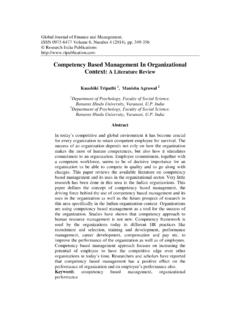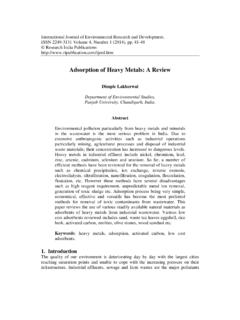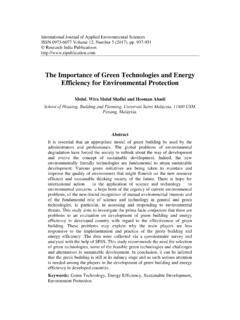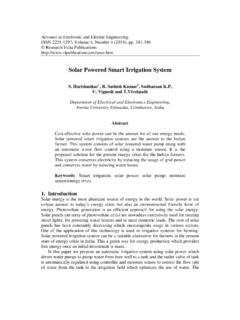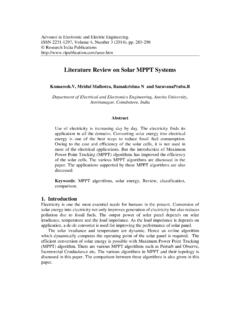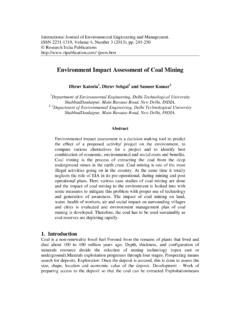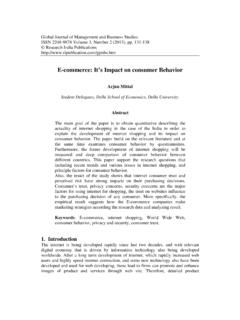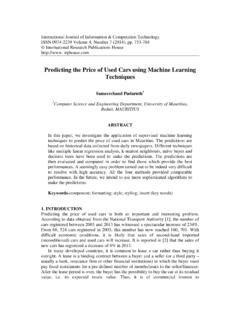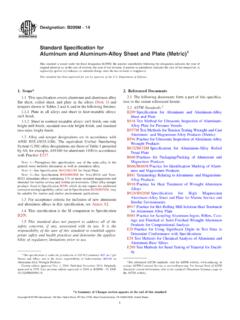Transcription of Advanced Composite Material for Aerospace Application-a …
1 International Journal of Engineering and Manufacturing Science. ISSN 2249-3115 Volume 7, Number 2 (2017), pp. 393-409 Research India Publications Advanced Composite Material for Aerospace Application-a Review Mohammad Arif, Dr. Mohammad Asif, and Ahmed Mechanical Engineering Department, OPJS University, Rajasthan Abstract For the Aerospace Engineering there are huge progress of Material science and engineering with the technological challenges in terms of the development of sophisticated and specialized materials Composite materials. At present composites Material are becoming important in Aerospace engineering due to its increased strength at lower weight, stiffness and corrosion resistance. This paper investigates the Composite materials used in Aircraft structure and also reviews the Advanced composites as structural materials. Progressive development allows their application in new areas for further uses in future. Keywords: Composite materials, Aerospace applications, latest research & developments.
2 INTRODUCTION Aerospace Engineering has actual the promoter for the development of Advanced engineering materials. The Advanced Material development depends on their properties such as, Strength, stiffness, damage tolerance, density, and corrosion resistance, at ambient and high temperatures. At present life cycle costing has been recognized as an tool to assess the economic acceptability of the Material (exception to Aerospace engineering). A reduced take-off weight of an aircraft, space vehicle or satellite directly affects the amount of fuel burned, causes enormous economical and ecological benefits with light weight design. Composite MATERIALS A Composite Material is made when two or more different materials are combined 394 Mohammad Arif, Dr. Mohammad Asif, Ahmed together to create a superior and unique materials. The stronger Material referred as reinforcement and the weaker Material is referred as matrix.
3 The reinforcement provides the strength and rigidity which helps to support the structural loads. The matrix or the binder help to maintain the position and orientation of reinforcement and more brittle, but when these two materials are combined which is light weight ,stiff, strong and tough. ORIGINS OF Composite MATERIALS The rapid development and use of Composite materials beginning in the 1940s had three main driving forces. Military vehicles, such as airplanes, helicopters, and rockets, placed a premium on high-strength, light-weight materials. While the metallic components that had been used up to that point certainly did the job in terms of mechanical properties, the heavy weight of such components was prohibitive. The higher the weight of the plane or helicopter itself, the less cargo its engines could carry. Polymer industries were quickly growing and tried to expand the market of plastics to a variety of applications.
4 The emergence of new, light-weight polymers from development laboratories offered a possible solution for a variety of uses, provided something could be done to increase the mechanical properties of plastics. The extremely high theoretical strength of certain materials, such as glass fibers, was being discovered. The question was how to use these potentially high-strength materials to solve the problems posed by the military's demands. One may conveniently speak of four generations of composites: 1st Generation (1940s): Glass Fiber Reinforced Composites 2nd Generation (1960s): High Performance Composites in the post-Sputnik era 3rd Generation (1970s & 1980s): The Search for New Markets and the Synergy of Properties 4th Generation (1990s): Hybrid Materials, Nan composites and Biomimetic Strategies. The First Generation (1940s): Glass Fiber Reinforced Polymers (GFRPs) While it seems obvious that making whole components (wings, nose cones, helicopter rotors, etc.)
5 Out of these high strength materials would be the answer, this was not the solution. These materials, while strong, were also brittle. Because of this, when they failed, they did so terribly. The theoretical high strengths could be severely undermined by flaws in the Material , such as a micro crack on the surface. Also, the stress-to-failure varied widely between what should have been identical components, because the number of flaws and their sizes were different for each manufactured Advanced Composite Material for Aerospace Application-a Review 395 piece. Since the number of flaws generally scales with the size of component, the only solution was to use short fibers of the high-strength materials to minimize the flaws in the system. But what use were short glass fibers? By themselves they seemed to be laboratory curiosities at most, with no real applications. An addition of Materials Properties However, engineers soon realized that by immersing fibers in a matrix of a lightweight, lower-strength Material , they could obtain a stronger Material because the fibers stop the propagation of the cracks in the matrix.
6 A polymer with insufficient strength or stiffness to act as an airplane wing could be reinforced with these new, fibers to produce a stronger, stiffer, lighter-weight product. The polymer "matrix" provided an environment for the fibers to reside in their original form - single, independent needles - and protected them from scratches that might cause them to fracture under low stress. The fiber "reinforcement" added strength to the more fragile polymer Material by shouldering much of the stress that was transferred from the polymer to the fiber through their strong interfacial bonds. The reinforced plastics emerged from engineering milieu rather than from scientific research. While solid-state scientists focused on the relation between structure and properties, industrial researchers were more concerned with the relations between functions and properties. The predominance of function over structure inspired Composite materials, materials made of two or more heterogeneous components.
7 At the same time, chemical companies were conducting research into new polymers. Phenolic, urea, and aniline-formaldehyde resins were developed in the early 1930s , along with the unsaturated polyester resins patented in 1936 that would come to dominate the composites field. in Switzerland received the first patent for epoxy resins in 1938, and soon licensed the patent to Ciba. While these new thermoplastic and thermosetting resins were being investigated for stand-alone applications - packaging, adhesives, low-cost molded parts - their potential use as a matrix for stronger materials was also kept in mind in order to expand the market of plastics. Mixing polymers with various additives - such as chargers, fillers, and agents of plasticity was already a well established tradition in chemical industries. The increasing importance of polymers in industry is evident in the founding of the Society of the Plastics Industry in 1937, followed by the Society of Plastics Engineers in 1941.
8 The emergence of scientific societies can indicate a level of widespread interest in a subject - a critical mass of sorts - that moves people from different companies and universities to gather together to exchange information about the latest findings. The Beginnings of the Reinforced Plastics Industry: GFRP 396 Mohammad Arif, Dr. Mohammad Asif, Ahmed Typically, the glass fibers were added to the polymer melt, which was then poured into a mold. Engineers and technicians had to learn the best ways to add the fibers so they were evenly distributed throughout the matrix, instead of clumped together. High pressure was applied to the early resins to get them to cure, but this caused some problems: the glass fibers were easily damaged at high pressures. To alleviate this problem, Pittsburgh Plate Glass developed some low pressure allyl polyester resins in 1940, and in 1942 Marco Chemical Company in Linden, New Jersey, was hired to investigate other low-pressure curing resins.
9 In 1942 the first fiberglass laminates made from PPG CR-38 and CR-39 resins were produced. The earliest applications for GFRP products were in the marine industry. Fiberglass boats were manufactured in the early 1940s to replace traditional wood or metal boats. The lightweight, strong fiberglass composites were not subject to rotting or rusting like their counterparts, and they were easy to maintain. Fiberglass continues to be a major component of boats and ships today. In 1942, the Navy replaced all the electrical terminal boards on their ships with fiberglass-melamine or asbestos-melamine Composite boards with improved electrical insulation the Wright-Patterson Air Force Base in 1943, exploratory projects were launched to build structural aircraft parts from Composite materials. This resulted in the first plane with a GFRP fuselage being flown on the base a year later. Another significant advancement was the development of tooling processes for GFRP components by Republic Aviation Corporation in 1943.
10 The ability to cut and trim components to size reduced waste and added flexibility to the manufacturing of complex components. Pre-impregnated sheets of glass fibers in a partially-cured resin, or pre-pregs, made manufacturing of components easier. By placing the fibers on a plastic film in a preferred orientation, adding the resin, pressing, and then partially curing the resin, flexible sheets of a precursor Material could be produced. Pre-pregs eliminated the early production steps for manufacturers trying to avoid the resin and glass fiber raw materials. These sheets could be cut to shape, stacked, and consolidated into a single piece by pressure and first commercial composites were called glass fiber reinforced plastics and, remarkably, they still dominate the market today, comprising about 90% of the composites market. Second Generation (1960s): High Performance Composites in the post-Sputnik Era: GFRP technology spread rapidly in the 1950s.

